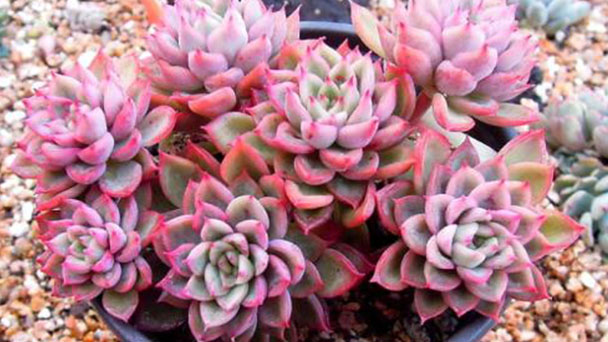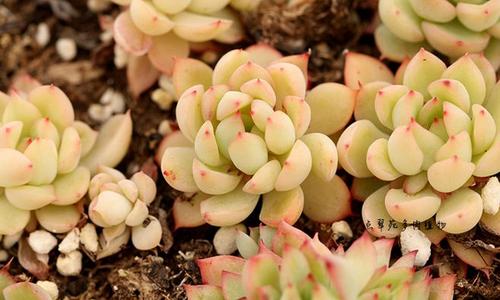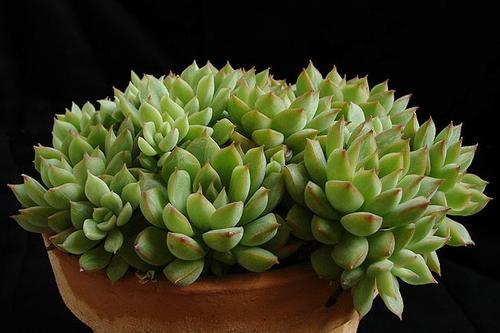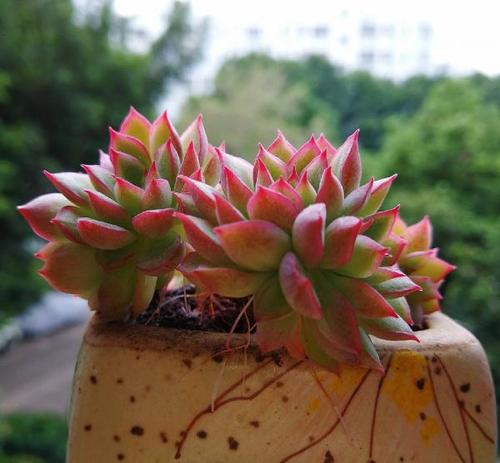Echeveria Mebina Profile
Written by Maggie
Nov 03 2021

Echeveria Mebina is a succulent plant of the genus Echeveria in the Chloridaceae family. It is characterized by a small plant shape and orange-pink margin. It is very prone to lateral shoots, perennials can form spectacular large communities. The short forms of leaves cultivated in horticulture are also called rain and zhang.
Echeveria mebina succulent is a kind of small stone lotus, which needs less sunshine than other stone lotus, but grows faster than other stone lotus. Its small size and tender color are suitable for making small pot combinations.
Echeveria Mebina Picture

Characteristics of Echeveria Mebina Succulent
The leaves of Echeveria Mebina succulent are slender, plump and spatulate, with pale green color. When the light is sufficient and the temperature difference is large, the tip of the leaves turns bright pink and is easy to cluster.
Echeveria mebina succulent likes dry, ventilated environments and can tolerate semi-shade. Echeveria Mebina succulent is relatively drought-tolerant and can be watered once a week in the growing season. In summer, when the temperature is high, it will enter the dormant period, so water should be controlled and shade properly. In winter, when the temperature is above 5℃, it can normally grow, and winter watering time should be at noon. If the basin is turned in spring, bone powder can be used as base fertilizer. The base fertilizer is sufficient for the whole growing season.
Echeveria Mebina is light green most of the time, but in sunny spring and fall they take on a beautiful pink tinge at the tip. The color will be brighter and more beautiful if placed in a dry place. Don't water until the plants are completely dry. Tilt the non-porous containers to drain the excess water.It grows all year round and requires less sunlight than other stone lotus plants!

How to Care for Echeveria Mebina
Echeveria Mebina Watering
In the spring and autumn growing season, Echeveria Mebina can be watered with enough water. When the soil is nearly dry, the water can be watered once. When it is hot in summer, attention should be paid to water control.Watering time can choose spring and winter near the noon warmer time period and summer afternoon or evening cooler time period. Soil with good air permeability and drainage can be selected, such as peat soil, granular soil 1:1 ratio configuration.
Growing season watering thoroughly, dry air can sprinkle water around the Echeveria Mebina, but the leaf, especially the center of the leaf should not water, otherwise it will cause rotten heart, summer high temperature dormant period to moderate shading, ventilation and water saving, winter to keep the basin soil slightly dry; Growing period fertilization generally every 20 days or so.
If the temperature can maintain above 0 degrees in winter, it is possible to supply water. If the temperature is below 0 degrees, the water will be cut off, otherwise it will be easy to frostbite. Although the cold winter, but also not a winter do not give a little water, will be at the appropriate time to give a little water in the root of the plant, do not spray or give water, leaf water stay too long, easy to cause decay. When the temperature rises in the spring, the water will slowly return to normal. Echeveria Mebina is a very easy breed to keep, with full sunshine in all seasons except summer, when proper shading is required.
Echeveria Mebina Light Requirements
The plant type of Echeveria Mebina needs full sunlight to compact and gather, and the red edge of the leaves will be more obvious and more ornamental. Therefore, the echeveria mebina can be cured in full sun and shaded properly in midsummer.
Echeveria Mebina Seedlings
The Echeveria Mebina purchased online can be planted with moist soil (as dry as possible) during the slow seedling period. Place the Echeveria Mebina ina bright and ventilated place for 1-2 weeks, and then gradually increase the illumination. During this period, water can be watered as appropriate, which can effectively avoid the breeding of germs, blackening and decay in the ventilated environment.
Echeveria Mebina Summer & Winter Care
Growing Echeveria Mebina is not difficult in summer, as long as you pay attention to a little shade in midsummer, but you should pay attention to watering and strengthen ventilation, watering time can be chosen at night. Winter temperature is lower than 0℃, should control watering or water, if again low, you should move into the indoor winter, try to choose the indoor sun.
Echeveria Mebina Temperature & Soil Care
The suitable temperature for Echeveria Mebina growth is 15-25 degrees, not less than 5 degrees in winter. When raised in the open air, once the temperature is higher than 35 degrees, it will move to the bright scattered light and slowly cut off the water. During the dormant period of the whole summer, there is little or no water. When the temperature is cooled in autumn, the water will resume.
With soil generally with peat + vermiculite + perlite each, and add the right amount of bone meal, can also be used leaf soil 3, 3 river sand, 1 garden soil, 1 slag mix preparation. The soil can also be mixed with coal cinder river sand and other particles of peat. The soil surface is paved with clean particles of river sand and the soil is mainly breathable.
How to Propagate Echeveria Mebina Succulent
The propagation mode of Echeveria Mebina Succulent is similar to that of other succulent plants, mainly including leaf propagation, branch propagation, sowing propagation and plant separation propagation.

Echeveria Mebina Uses
Mini petite body and spring and autumn Echeveria Mebina is very attractive, very suitable for small combination potted plants. The growth rate is faster than other stone lotus, you can also try to let the branches lignified after the separate cultivation landscaping, group growth speed is very fast!Read Next:
Echeveria Elegans Mexican Snowballs Care & Growing Guide
Echeveria Laui (Echeveria Succulent) Care Guide
Echeveria Agavoides Care & Propagation
Echeveria Pulvinata (Chenille Plant) Care & Propagation Guide
Echeveria Nodulosa (Painted Echeveria) Care Guide
Echeveria Imbricata (Blue Rose Echeveria) Grow & Care Guide
Echeveria Setosa: Grow & Care for Mexican Firecracker
Echeveria Black Prince Succulent Grow & Care Guide
Echeveria Runyonii Topsy Turvy Grow & Care Guide
Echeveria Takasago No Okina Care Guide
Latest Updated
- Benefits of Bugleweed - 7 Science-backed Health Benefits
- Bugleweed Dangers & Side Effects - Is It Poisonous?
- How to Plant Evergreen Trees - What You Should Know
- When to Plant Evergreens - Grow Guide for Evergreen Trees
- 12 Wonderful Evergreen Shrubs for Your Garden
- 12 Popular Evergreen Plants with Pictures for Beginners
- When And How To Prune A Lilac Bush Like a Pro
- How to Grow & Care for Lilac Vine (Hardenbergia Violacea)
- Japanese Lilac Tree (Syringa Reticulata) Care & Propagation Guide
- Shumard Oak Pros and Cons - What to Know
Popular Articles
- Winter maintenance of Antirrhinum Majus
- How to Grow Terminalia Mantaly Tree
- How to Grow and Care for Crossostephium Chinense
- How to grow Antirrhinum Majus in spring
- Peristeria Elata (Dove Orchid) Profile: Info & Care Guide
- Underwatered Snake Plant (Sansevieria Trifasciata) - Signs And How To Fix
- How to Care for Brazilian Jasmine Plant (Mandevilla Sanderi)
- How to Grow & Care for Graptopetalum Purple Delight in Summer
- Rosa Chinensis (China Rose): Plant Growing & Care Tips
- How to Care for Baby Sun Rose (Aptenia Cordifolia)